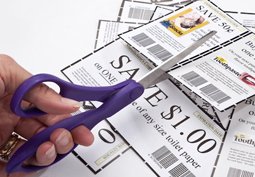Frugal Foodie (@MintFoodie)
It’s called “extreme couponing” for a reason — it takes effort and strategy to cut your grocery bill by 50% or better.
But even if your aim isn’t to corral enough free tuna fish and toilet paper to live on for a few years, there are plenty of fast strategies novice couponers can incorporate to boost their savings.
We asked avid coupon-clippers to share some of their most effective tricks to get newbies on track. Build on them, and you’ll be well on your way:
Be patient.
“Never use a coupon as soon as it comes out,” says Isra Hashmi of The Frugalette.com. It’s better to wait until there’s a good sale to pair it with, which usually happens within a week or two.
Save on your Sunday paper.
It’s where many of the most valuable coupons are, but paying for the paper eats into that cost.
Laura Harders of BeltWayBargainMom.com says she waited for a 70%-off-for-new-subscribers deal to sign up for her Sunday paper, and she renegotiates her rate every time the subscription comes up for renewal.
Broaden coupon sources.
“Knowing where to find coupons is half the battle,” says Kendal Perez of HassleFreeSavings.com.
Beyond the Sunday paper, check the sites of your favorite grocers — many have digital coupons you can load directly to a store loyalty card.
There are coupons sites, like Coupons.com and RedPlum.com, for digital versions and many companies also post deals on their own sites and Facebook pages.
“You can also find coupons on the backs of grocery receipts and ticket stubs, in magazines and in peel-off versions on the products themselves,” she says.
Swap.
Couponer Marcia Layton Turner suggests newbies clip all the coupons they can — to trade. “Some libraries and community centers have coupon exchange boxes where you can swap what you have for what you need,” she says.
There are also so-called coupon trains, where you receive regular mailings of coupons. Take what you need, refill the envelope with clipped coupons you don’t plan on using, and pass it down the chain.
Track local sales…
“Start studying the weekly grocery store flyers to spot sales on products for which you have coupons,” says Layton Turner.
“That’s how extreme couponers maximize their savings: They find a product that retails for, say, $2.99, that is on sale for $1.50, and has a $.75 coupon in circulation that can be doubled to make the product free.”
There are also plenty of coupon bloggers that track the sales for you and point out the best deals.
… But start slow.
“If you start off by trying to actively coupon at too many stores, you’ll likely get overwhelmed and burnt-out, which can quickly lead to abandoning couponing altogether,” says Harders.
She suggests starting off with one or two stores you already frequent, and building as you learn to coupon.
Hunt down doubling.
Stores often double the value of coupons at checkout. “But check the policy first,” says Scott Gamm, founder of HelpSaveMyDollars.com.
“Stores may only double during certain days, or even certain times of day,” he says.
Stack discounts.
Don’t limit yourself to one coupon. “Retailers accept one store-issued coupon and one manufacturer’s coupon per product,” says Hashmi.
Stick to what you like.
Branching out beyond brands you normally buy can lead to more savings. “But don’t collect coupons for products you wouldn’t otherwise buy without a discount,” says Perez. (Couponers call that kind of spending to save “spaving.”)
In the end, you’re spending more than you might otherwise.
Go small.
“If the coupon does not state a specific size quantity, use it on the smallest size possible to get the item for free or very cheap,” says Hashmi. For example, a $1 coupon for toothpaste could get you a free travel size.



